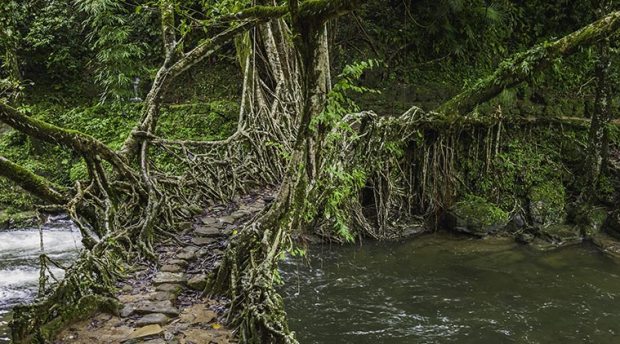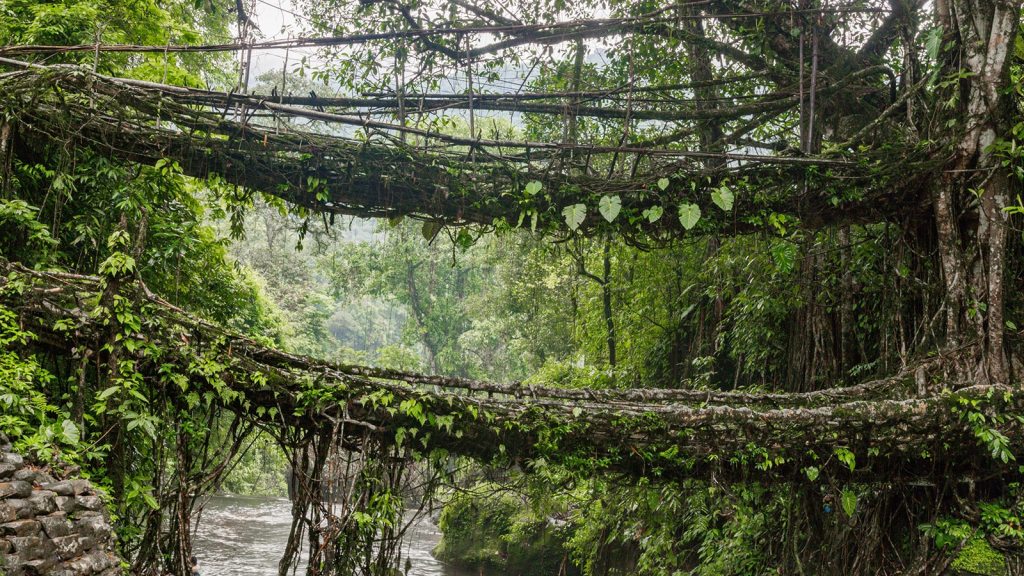In the mist-shrouded hills of Meghalaya, where the skies often weep in endless rain, nature has gifted the world one of its most unique wonders—the living root bridges. These bridges, found predominantly in the Khasi and Jaintia Hills, are not built but grown, painstakingly shaped over decades by the indigenous Khasi tribes.
The living root bridges are made from the aerial roots of the Ficus elastica tree, commonly known as the Indian rubber fig. Unlike conventional bridges, these natural structures are alive, growing stronger and more resilient with time. As the roots stretch across rivers and streams, they are guided by the hands of the local villagers, sometimes taking 10 to 15 years to fully form. However, once matured, these living bridges can last for centuries, with some estimated to be over 500 years old.
Why Visit the Living Root Bridges?
For the intrepid traveler, the journey to these bridges is an adventure in itself. The most famous living root bridges can be found near the village of Nongriat, which requires a trek of nearly 3,000 steps through a dense tropical forest. Along the way, visitors are treated to panoramic views of Meghalaya’s emerald-green hills, roaring waterfalls, and the enchanting music of chirping birds.
The most iconic of these is the Double Decker Living Root Bridge, a unique two-tiered structure that has become a symbol of Meghalaya’s eco-friendly traditions. During the monsoon season, the surrounding region transforms into a verdant paradise, with the rivers flowing full and strong beneath the bridge, adding to the awe of the experience.

Sustainable Engineering
What makes these root bridges remarkable is not just their aesthetic or functional appeal, but their eco-friendly and sustainable nature. In a world where modern infrastructure often battles with environmental conservation, the Khasi people have shown that living in harmony with nature yields remarkable results. As the roots of the rubber tree are resistant to rot, especially in the region’s damp conditions, they continue to strengthen over time, with minimal maintenance.
For the Khasi tribes, these living root bridges are more than just a mode of transport—they are a cultural heritage. Passed down through generations, the knowledge of cultivating these bridges is a symbol of the community’s deep bond with their natural surroundings. Many of these bridges are located near sacred groves, which are protected forest areas considered holy by the local people.
How to Experience Them
The best time to visit Meghalaya’s living root bridges is during the monsoon season or shortly after, between June and September, when the region is at its lushest. Travelers typically base themselves in Shillong, the capital of Meghalaya, and embark on a day or overnight trek to the villages of Nongriat, Cherrapunji, and Mawlynnong, where many of these natural wonders can be found.
A trip to see these living root bridges is not only a trek through nature but also a journey into a way of life that harmoniously blends human ingenuity with the environment. It’s an opportunity to witness firsthand how traditional knowledge can offer sustainable solutions for future generations.
For those who crave the experience of nature in its most profound form, the living root bridges of Meghalaya provide a window into a world where the boundaries between human creativity and the natural world blur. These living structures are an ode to patience, craftsmanship, and the eternal bond between people and their environment—a journey well worth taking in the Land of Clouds.
Nestled in the rain-soaked valleys of the Khasi and Jaintia Hills, the living root bridges of Meghalaya are functional masterpieces, each a testament to centuries-old traditions and the region’s deep connection with the environment.
Disclaimer:
This article contains sponsored content that may not reflect the independent opinion or views of FinancialExpress.com. Further, FinancialExpress.com cannot be held responsible for the accuracy of any information presented here. Please consult a certified financial advisor before making any decisions based on this article.


